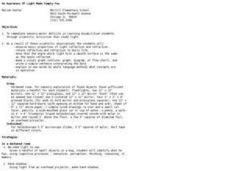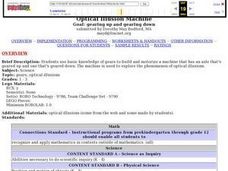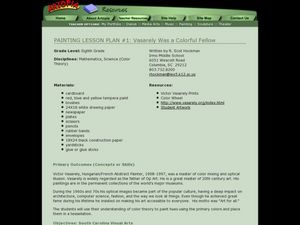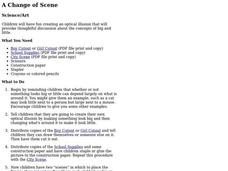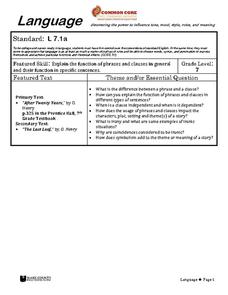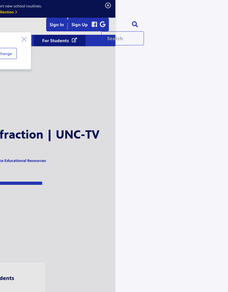Exploratorium
Fading Dot
Fuzzy edges cause an image to fade from view in an activity intended to demonstrate how vision works.
Exploratorium
Bird in the Cage
When your life science class is learning about the eye and how it works, you can add this activity as a demonstration of how the retina holds an afterimage. After staring at a red, green, or blue bird shape, pupils glance at a cage and...
Curated OER
Op Art and Contrast
Seventh graders explore the Op art movement and the work of artists Bridget Riley, Victor Vasarely and MC Escher. the principles of contrast and how it can be used to create optical illusions is examined in this instructional activity.
Curated OER
What is Retrograde Motion
For this retrograde motion worksheet, students draw a diagram of the night sky by connecting dots to show retrograde motion. They compare retrograde motion to an optical illusion and answer questions about both.
Curated OER
Fraggle Monster Vase
Students create an optical illusion. In this optical illusions lesson, students sketch a monster's face to create the optical illusion of a vase in the positive space. Students create an original piece of art.
Curated OER
An Awareness of Light Made Simply Fun
Learners with sensory perception issues discover the properties of light through a series of excellent hands on activities. They look at beams of lights in a darkened room; use a kaleidoscope and optical illusions as they experience the...
Curated OER
Mysterious Melodies
Students play brain tricks on one another. In this brain instructional activity, students cut out cards to show one another. They try to trick the other person into reading the cards incorrectly and look at other optical illusions.
Curated OER
Optical Illusion Machine
Young scholars explore optical illusions. Using Legos, they construct and motorize a machine that has an axle that's geared up and geared down, complete a worksheet, and answer discussion questions.
Scholastic
Optical Illusion
Number theory gets a workout in an activity that asks individuals to identify and color code the prime numbers and the composite numbers in the provided graphic.
Curated OER
Prime and Composite Numbers Optical Illusion
In this prime and composite numbers practice worksheet, students sharpen their math skills as they identify numbers as prime or composite to solve the optical illusion puzzle.
National Gallery of Canada
My Upside-Down World!
M.C. Escher is famous for creating optical illusions. Examine this effect in several of his works and discuss the techniques involved. Inspired by the discussion, learners create an imaginary 3-D world inside of a box using various...
Curated OER
Vasarely Was A Colorful Fellow
Eighth graders create artwork inspired by the work of Victor Vasarely. In this op art lesson plan, 8th graders explore color theory and color mixing. Students create ten shapes to use in their artwork and over the course of two weeks,...
Curated OER
Optical Illusions
In this algebra worksheet, students rewrite word problems using algebra symbols. There is an answer key with this problem.
Curated OER
A Change of Scene
Students create their own optical illusions by making something look big and then changing what's around it to make it look little.
Curated OER
A Change of Scene
Students are challenged to create optical illusions using using cut-outs. The activity provokes thoughtful discussion about scale.
Curated OER
Entering the Eye
The human eye is the focus of this biology PowerPoint. The presentation takes a virtual trip inside of the human eye and allows learners to view the various parts of the eye. The best part (for me) are all of the optical illusions that...
Curated OER
Color the Monsters
In these coloring the monsters worksheets, students color the monster faces making them either scary or merry. Students color two faces.
Curated OER
Exploring Optical Movement in Art
Students describe, represent and analyze patterns and relationships using shapes. They create simple geometric patterns. They demonstrate increasing technical ability and skill to complete visual arts assignments.
Curated OER
Anamorphosis
Students classify optical illusions according to their distinguishing characteristics. They create anamorphic art and use Mylar flexible mirrors to view and then they describe and analyze the optical illusion.
Wake County Public Schools
Language
Have your class doing everything from reading literature, analyzing literary devices, identifying independent and dependent clauses, discussing, and writing creatively with the rich resource found here. After a mini lesson on independent...
Exploratorium
Cardboard Tube Syllabus
Construct paper tubes and then try out a few optical illusion tricks:
See a virtual hole in your own hand
Get a grasp of how the eyes combine images
Notice that one eye is dominant over the other
Reveal how your eyes adjust to...
PBS
Reflection and Refraction | UNC-TV Science
Uncover the exciting interactions of light energy and matter ranging from color to optical illusions. Participants explore color using red and green apples, differences between reflection and refraction, and descriptions of related...
K12 Reader
The Art of M.C. Escher
Show your class one way in which art and math are related by teaching them about M.C. Escher. Class members read a brief passage and then respond to five related questions.
Curated OER
Psychedelic Checkerboard Op Art
Students analyze optical illusions from the packets, both individually and as a class. They create an original optical illusion design using pattern and repetition. They determine which color needs to be in the pattern.
Other popular searches
- Printable Optical Illusions
- Optical Illusions Art
- Geometry Optical Illusions
- Math Optical Illusions
- Science Optical Illusions
- Optical Illusions Designs
- Optical Illusions Bird Cage
- Fractions Optical Illusions







